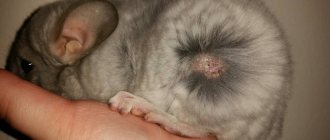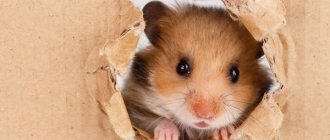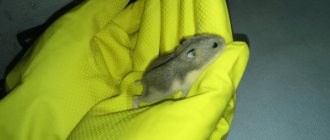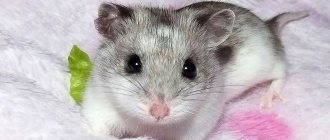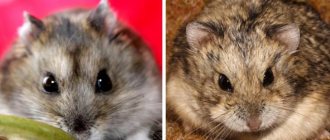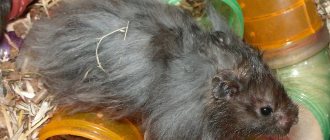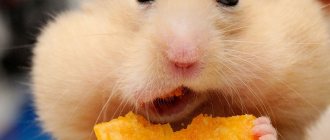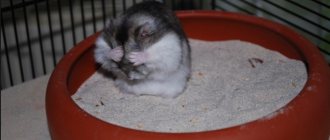A healthy hamster's coat is thick, shiny and silky. But there are periods when the pet renews its fur and in the process loses part of it - this is a normal phenomenon. However, baldness often occurs due to vitamin deficiency, allergic reactions, parasites, and infectious diseases.
Let's find out what other causes of hamster baldness are and how to prevent the development of such diseases.
How does natural molting occur in hamsters?
If a little hair remains on your hands when stroking a rodent, this does not always indicate problems with the animal’s health. This situation is often the result of natural shedding. At this time, the animal can completely or partially change its coat. The rate of hair loss depends on the conditions of detention, as well as the breed of the rodent. There are 2 main types of shedding:
- seasonal;
- age.
Seasonal shedding in hamsters occurs more often in spring and autumn. Breeds that hibernate change their coat during the summer. The pet renews its fur gradually. The process lasts for 2 weeks, so many owners of such rodents do not notice these changes and do not know whether the hamsters shed or not. During the renewal process, the color of the coat may change depending on the season.
Age-related molting is typical for both young individuals and old ones. The first renewal of the coat occurs approximately in the 4th month of the animal’s life. At this time, the soft fluff covering the hamster's body changes to a harder and denser cover.
The average lifespan of an animal is 2 years. As you age, your fur begins to fall out more rapidly, without having time to renew itself. This causes the cover to become less dense.
It is quite simple to distinguish natural shedding from pathological hair loss in a hamster. In the first case, hairs die off on all parts of the animal's body. In this case, large bald spots do not form. In addition, the naturalness of the process is indicated by the absence of scratching and itching. In this case, the hamster eats normally and behaves actively. Natural molting does not affect his health.
Ectoparasites
I would like to immediately clarify that fleas and lice eaters are quite rare. Mostly, fleas appear on furry animals when another animal lives nearby. Migrants may initially live on your cat or dog.
A flea bite produces saliva, which causes itching. The only good thing about fleas is that they are impossible to miss. Therefore, it will not be difficult to make a diagnosis. The animal may feel relatively well in terms of appetite and general condition.
You should be wary of Sarcoptes anacanthos mites, as the disease sarcoptic mange is much more complex. The hamster literally combs and leaves many wounds on the skin. It happens that there is no healthy place left on the animal. This form can very quickly end in death.
By the way, do you know how to make a maze for a hamster with your own hands? Look, it's interesting!
Pathological hair loss: causes and symptoms
Hair loss in an animal can be provoked both by the influence of certain environmental factors and by certain diseases that provoke malfunctions in the rodent’s body. It is extremely important to identify the cause of the problem. This will help determine what to do if your hamster is going bald.
Stress
This animal is quite shy. It loves silence and solitude. The following can cause stress in a hamster:
- moving;
- rearrangement in the cell;
- house replacement;
- the appearance of a new pet;
- diet changes, etc.
In addition, rodent anxiety is often caused by human actions. Hamsters are nocturnal. During the daytime they sleep. Loud noises, music and other noise can frighten a rodent and affect its mental state. During periods of stress, the animal's glands may become more active. This often leads to hair loss in certain areas of the body. Most often, bald spots form on the head and abdomen.
Stress can cause an animal to shed.
Poor nutrition
The hamster's body does not produce many types of vitamins. In addition, he does not always receive all the necessary minerals from food. A monotonous diet can negatively affect the condition of the coat. Poor nutrition often causes the development of dysbiosis in hamsters. This negatively affects the absorption of nutrients in the intestines.
Hair loss due to vitamin deficiency is more often observed in hamsters that have consumed only dry food consisting of cereals for a long time. It does not contain enough vitamins and minerals for the normal functioning of the animal.
Vitamin deficiency is often accompanied by hair loss on the rodent's ears. In this case, there are no signs of an inflammatory process. The skin in bald areas is very flaky. To eliminate the problem, it is important to adjust the rodent’s diet.
Fungus and skin parasites
Even with regular cleaning of a hamster's cage, there is a risk of your pet becoming infected with fungus or skin parasites. Pathogenic microorganisms may be contained in feed or bedding. Fungal infections often affect older rodents with weakened immune systems.
The first signs of the disease do not appear immediately. About a month after infection, bald patches appear on the sides, face and ears. The lesions are initially smooth and have clear boundaries. Subsequently, signs of an inflammatory process appear. Without treatment, purulent formations form on the animal’s skin, covered with scabs on top.
The progression of the disease causes great discomfort to the pet. He experiences severe itching, so he scratches the affected areas. In addition, the hamster's appetite worsens, it becomes lethargic and irritable. When the first signs of infection appear, you need to contact a veterinarian to conduct tests and clarify the type of fungus that has affected the skin of the rodent. Only after this can effective treatment be prescribed.
Skin parasites often cause baldness in hamsters. Pets are more often infected with scabies mites. Parasites provoke not only hair loss, but also severe itching. Because of this, the hamster begins to scratch the lesions that bother him. Bald patches often form on the ears, cheeks and near the anus. Subsequently, a secondary infection occurs, which leads to the formation of plaque and scabs. The hamster loses his appetite. In severe cases, fungal infections and skin parasites cause the death of the animal within a few weeks or months.
Allergy
If your hamster itches and goes bald, the problem is often an allergic reaction. It can be triggered by toys in the cage, new food, or hygiene products used when cleaning the house. It is extremely difficult to determine exactly what caused the allergic reaction. In most cases, to fix the problem, you need to adjust the animal's menu and remove all recently purchased toys and accessories from the cage.
Allergies can also cause baldness.
Hormonal disbalance
Pregnant females often experience hair loss due to a lack of vitamins and minerals in the body. Correcting the diet and special supplements can quickly eliminate this problem. In addition, females may lose fur on their belly and chest during the postpartum period. This is a natural mechanism that makes it easier to warm and feed the offspring.
If a female has symmetrical bald patches, the problem may lie in diseases of the reproductive organs. Often hair falls out with pyometra, i.e. purulent inflammation of the uterus, as well as endometritis.
Less commonly, the appearance of bald patches is caused by ovarian tumors. At the same time, females do not suffer from itching and other unpleasant sensations.
Weakening of the immune system
Hair loss in a hamster may indicate a malfunction of the immune system. The problem may be caused by:
- avitaminosis;
- lack of vaccinations;
- sudden change in diet;
- irregular cleaning of the cage;
- stress;
- acute and chronic diseases;
- previous surgery;
- injuries;
- antibiotic treatment;
- parasitic infestations, etc.
A weakened hamster's immune system not only leads to the formation of large bald patches, but also creates conditions for the development of bacterial, viral and fungal infectious diseases. If the problem is caused by a disorder of the immune system, not only the condition of the coat worsens. The animal becomes lethargic, its appetite decreases and its weight decreases. The pet spends most of its time in its house.
Abscesses
Infection in the subcutaneous fat of a hamster can provoke the formation of a purulent abscess. A similar disorder often develops if a rodent combs its fur. This defect is formed when the hair follicle becomes infected with microflora from the rodent’s oral cavity.
First, hair falls out over the site of the abscess formation. The affected area takes on a reddish tint. It becomes warmer to the touch. Light flaking may be present.
Gradually the focus increases. A mature abscess in most cases opens on its own, which leads to the leakage of pus and cleansing of the wound. If this does not happen, you need to contact a veterinarian to open the formation, sanitation and prescribe a course of antibiotics and external treatment. After the wound heals, the fur is restored.
At the site of the abscess formation, the rodent combs out the fur.
Irritation from urea
The appearance of a bald patch on the lower abdomen and hind legs may be due to the systematic contact of the animal’s urine on its skin. The integuments acquire a red tint and begin to peel off. Frequent urination often occurs against the background of inflammatory diseases of the bladder. To eliminate the problem, you need to consult a veterinarian to prescribe comprehensive treatment.
Wool abrasion
Bald patches on the back of the head and paws can occur if the hamster often runs in a narrow maze. If the rodent is able to stick its head between the bars of the cage, the hair falls out on the neck. To solve the problem, you should purchase accessories that are suitable in size for the animal. In addition, you may need to purchase a cage with a high, smooth plastic tray.
Age-related alopecia
Some rodents have a genetic predisposition to balding in old age. This feature is passed on from one generation to another. In this case, alopecia lesions begin to appear in related hamsters at approximately the same age. Special vitamin supplements will help slow down the process of hair loss.
Bacterial and viral diseases of the hamster
Hamsters are very susceptible to diseases caused by pathogenic microorganisms, viruses, and bacteria. Infection is possible by contact, aerogenous, nutritional means, or by eating low-quality feed. Some diseases of bacterial etiology can be transmitted to hamsters from humans and other pets.
Colibacillosis
The infection is caused by Escherichia coli, which parasitizes the gastrointestinal tract of animals. This disease of dzhungarik is also known as “wet tail”, as the sore is manifested by severe diarrhea.
Skin diseases in hamsters
Parasitic and infectious skin diseases that cause baldness are the most dangerous, because without targeted treatment, the affected area quickly increases in size. Without the use of medications, the likelihood of your pet dying is high.
Scabies
If the hamster begins to itch, its hair falls out and its skin peels off, this may indicate that the rodent is infected with scabies mites. Touching the affected area is painful for the animal. In advanced cases, the pet can lose up to 90% of its fur. You need to contact a veterinarian to prescribe therapy and select a drug. More often, Ivermectin or Otodectin are used to treat this disease. To determine the dose, the weight of the animal is taken into account. The average weight of a Djungarian hamster is 50 g, and a Syrian hamster is 150 g.
Hair loss and peeling skin may indicate the presence of scabies.
Lichen
With lichen, rounded bald patches form. The animal's skin is very flaky and itchy. A common reason why a hamster develops this disease is a decrease in immunity due to improper care. It is imperative to show the animal to a veterinarian. He will prescribe vitamins and also select an antifungal ointment or spray.
Diagnostics
The most common cause of baldness in domestic hamsters is infection with lichen. Moreover, it is not always possible to determine the presence of lichen in a hamster at the initial stage. Baldness caused by lichen appears first on the back, then on other parts of the body. In areas of baldness, you can notice small scales and wounds from scratching. If an animal constantly scratches due to unbearable itching, it most likely has lichen.
Treatment of a hamster that has become bald from lichen is carried out using special ointments. But you shouldn’t get carried away with self-medication. After all, in nature there are many varieties of lichen. Each case requires individual and well-chosen treatment.
The second reason, which is often accompanied by baldness of a domestic hamster, is an overabundance or lack of vitamins. You shouldn’t stuff your animal with everything in order to get rid of this problem. First you need to establish the cause. For this purpose, the veterinarian conducts an in-depth diagnosis of the pet:
- take a skin scraping;
- will inspect the affected areas under a special lamp.
A comprehensive diagnosis will help determine the cause of baldness, after which a specialist will prescribe the necessary treatment for your animal.
How to help a hamster with hair loss
Improving living conditions and correcting nutrition will speed up the process of restoring the rodent's fur. In addition, this will reduce the risk of complications.
New filler
Contaminated litter contains a lot of bacteria. To avoid infection of your receding hairline, you should replace it. It is better to use scraps of clean paper rather than sawdust. Magazines and newspapers are not suitable for this purpose, since the paint applied to them can be dangerous for rodents. The litter should be changed once every 3 days.
Cell disinfection
To speed up your hamster's recovery, you need to thoroughly disinfect the cage and all accessories once a week. You cannot use bleach for this, as it is dangerous for the animal. Special means are better suited, these include:
- Laina.
- ZooSan.
- GetZoo, etc.
Diet correction
Changing the diet is an important condition for the rapid restoration of the hamster's coat. The animal needs to be given not only grain mixtures, but also vegetables, fruits and herbs. It is recommended to introduce boiled egg whites or meat into the diet approximately 2-3 times a month.
Eliminating stress
If the hamster tries to hide in the house, there is no need to disturb him. You should not talk loudly or play music in the room where the animal’s cage is located. It is worth refusing to replace the accessories familiar to the rodent. You should not wake your hamster during the day.
First aid
Finding out the causes of baldness
It is not always possible to seek help from a specialist. After all, not every locality has a veterinary clinic. What to do in this case? If your hamster is going bald, you will have to take remedial measures yourself. The causes of hamster baldness should be excluded and checked gradually and in order.
Filler
This is the first thing you need to pay attention to. There are many good and not so good fillers. Some of them can cause an allergic reaction in a pet and the development of infectious diseases. Whatever the filling in the cage, at the moment when the animal itches and loses hair, it must be completely removed.
Tasty alternative
Don't be upset if for some reason you can't provide your pet with carrots. As for vegetables, there is a complete variety for rodents! They can eat peppers, zucchini, eggplant, cucumbers, radishes, beans, pumpkin, squash, cauliflower, broccoli, radish, and corn. The list of permitted products can be very long, so it’s easier to concentrate on the dangerous ones.
It is not advisable to feed rodents white or red cabbage, potatoes, sorrel, and garlic. Also dangerous can be pits from food and any plants grown in environmentally polluted conditions, such as cities, near roads.
Keep a male and a female in the same cage if you do not plan to have babies
Some inexperienced owners buy a pair at once - a female and a male, believing that they will have much more fun together.
However, one should not rush to conclusions. If you put a boy and a girl in the same cage, then one day they will make you happy with offspring. And it will not be one or a couple of small animals, but at least a dozen at once.
If you are not ready to breed these rodents, then it is better to purchase one. Hamsters themselves are not social animals; they do well without company, in splendid isolation. And so that they don’t get bored, you can place various wheels, labyrinths and hammocks. Nowadays you can find a wide selection of products in the pet store.
VIDEO: The cutest hamster in the world, chewing carrots in a cozy place!
Many people have pets. Some dogs, some cats, guinea pigs or hamsters. Today we will talk about the latter.
Hamsters are very cute and gentle animals belonging to the subfamily of rodents. That's why they absolutely love to chew carrots and cabbage.
The hero of the next video, Mike the hamster, won the hearts of millions of Internet users. “How is he different from other hamsters?” - you ask.
This Japanese hamster resembles a baby who is sitting down comfortably and enjoying something tasty. Very funny and sentimental video.
Mike's favorite treat is carrots, which he is ready to gnaw for days. Indeed, the hamster settled in well. What else does he need?
Warmth, food, care - he has it all. A real heavenly life that millions of other rodents dream about! But, unfortunately, not everyone is as lucky as Mike.
The happy hamster looks at the camera and seems to radiate positive energy. It is very difficult to describe this amazingly cute creature in words; you need to look at it.
We recommend that you look at your pet with your own eyes. Don't forget to take a warm blanket and eat something tasty to keep Mike company while watching the video! Enjoy your viewing!
How to serve it to your pet
Be careful! In supermarkets and markets, vegetables are often saturated with chemicals and harmful nitrates. Carrots absorb them into their juices and then give them to those who consume them. In addition, in stores it is sprayed with a special substance, which gives it a fresh look and prevents rapid spoilage of the product.
Based on this, it is highly not recommended to buy food for your pet in these places. It’s better to buy it second-hand, or grow it yourself (it’s not as difficult as it might seem). But in this case, you will be sure that you will not poison the baby. After all, all these supplements greatly affect his well-being and health in general.
It is better to process raw carrots before serving to the hamster. Soak it in water until the nitrates come out of the vegetable. Then rinse it under running water to completely remove as much dirt and harmful substances as possible. Next, scrape off the top layer and dry. After such simple procedures, it will be safe to give your pet treats.
Some owners are interested in whether it is possible to give boiled carrots to babies. This is not prohibited if “extra” elements are not added to the vegetable. When cooking, do not add salt, pepper or spices. Also, you don’t need to cook it for too long, then the beneficial properties of the vegetable will be completely boiled out. And in general, boiled carrots make much less sense than raw ones. It stops sharpening your teeth, nourishing you with useful elements, and even quenches your thirst much more weakly. So think twice, why do you need it?
Bald animals (photo)
Many people were shocked to see what an owl looks like without feathers.
And this is a completely bald hedgehog.
This is a rooster without feathers.
The hairless Sphynx cat is one of the most expensive breeds.
This rabbit was born without hair.
The bald bear lost its fur due to a genetic disorder.
Little hairless puppy.
This raccoon lost its fur due to scab, a fairly common disease in animals.
Poor nutrition
Before you get yourself a furry pet, you should definitely familiarize yourself with its diet. Some products are strictly prohibited for him. For example:
- cabbage - any variety;
- milk - in its raw form causes severe distress;
- garlic;
- onion;
- some fruits, especially those that are too sweet.
Incorrectly selected products can not only cause disruption to the hamster’s gastrointestinal tract, but also injure its delicate body.
Solid foods must be present - for example, carrots. The rodent will sharpen its sharp teeth on it. Otherwise, they can grow greatly and become a real problem for him.
Popular breeds
Despite the ease of care, each type of domestic rodent has its own characteristics. Before choosing the breed of your future pet, you should take into account the habits inherent in its representative. This will help you quickly gain confidence in a tiny and naturally shy animal.
It is believed that the life expectancy of a hamster that is friends with its owner is much longer. After all, this way he is less likely to experience stress, which affects the general condition of the body.
Below are the most common domestic hamster breeds with a brief description.

